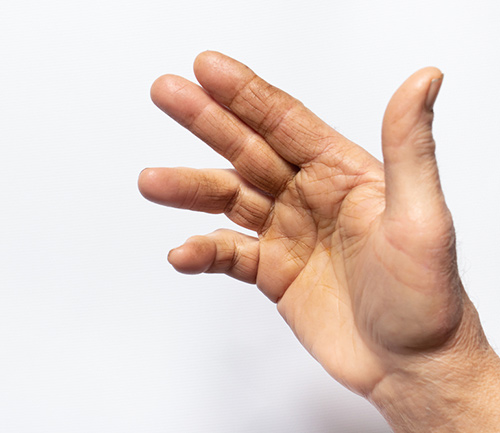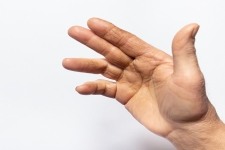
Dupuytren’s contractures are the abnormal thickening and tightening of the skin in the palm of your hand. This area of skin may develop into a hard knot of tissue, which can eventually cause the fingers to be permanently bent or crooked. Over time, the deformed tissue pulls one or more fingers to curl in toward your palm. The condition can affect either hand, but most commonly impacts the ring and little fingers.
In other terms, the layer of tissue that stabilizes the skin on the palm side of the hand is known as fascia. Fascia is why the skin on your palm is immovable but the skin on the back of your hand is elastic. Dupuytren’s contracture thickens and tightens the fascia, slowly hindering the functionality of the fingers.
What Causes Dupuytren’s Contracture?
The exact cause of Dupuytren’s is unknown, but it is believed to be linked to genetics. Some other common causes could be smoking, alcoholism, diabetes, nutritional deficiencies, or medicines used to treat seizures.
There are other reasons why people get bent fingers like arthritis, trigger finger, an injury, or reflex sympathetic dystrophy. It’s important to talk to your doctor about your symptoms to determine the proper diagnosis.
Who is at Risk?
Those that fit in the following are at a greater risk of developing Dupuytren’s contracture:
- Age – occurs typically after the age of 50
- Sex – more commonly developed in men than women
- Ancestry – people who have Scandinavian or Northern European backgrounds
- Family history – may be passed down through the bloodline
- Medication – some medicines used to treat epileptic seizures are linked to disease
- Lifestyle – smoking or abusing alcohol is linked to disease
- Health complications – people who have diabetes
What are the Symptoms?
Common symptoms may include:
- Nodules: One or more small lumps under the skin of the palms
- Cords: As the nodules thicken and contract, dense cords thicken and form under the skin that hinders mobility in the fingers.
- Contractures: As the nodules and cords tighten, one or more fingers may start to contract toward the palm. Patients lose the ability to spread their fingers — most commonly your ring and little fingers.
- Not being able to lay your hand flat on a table, palm down.
- Your hand does not work as well as it once did and may not be able to grasp objects or straighten fingers.
How is it Treated?
Dupuytren contracture is not fully curable and is not a dangerous condition, so some people choose not to get treated. If you choose to move forward with treatment, it will help slow the progression of the disease and limit your symptoms. Treatment plans can vary depending on the severity of the case, your health, age, how you handle medicines and therapy, and what you would like to do.
Treatments can be one or more of the following:
- Surgery
- Steroid shot
- Splints
- Radiation therapy
- Enzyme injection
- Needle aponeurotomy
Closing Thoughts
With Dupuytren’s contracture, it can be difficult to perform certain tasks using your hand. As the disease progresses, it can limit your ability to fully open your hand, grasp objects, and get your hand into narrow places. If you’re beginning to experience similar symptoms of Dupuytren’s, schedule an appointment with us at Prairie Orthopaedic & Plastic Surgery. We have a team of highly skilled orthopaedic surgeons and physical therapists to get your condition under control. To schedule an appointment, call (402) 489-4900.
References
Dupuytren’s Disease, OrthoInfo.
Dupuytren’s Contracture, Johns Hopkins Medicine.

